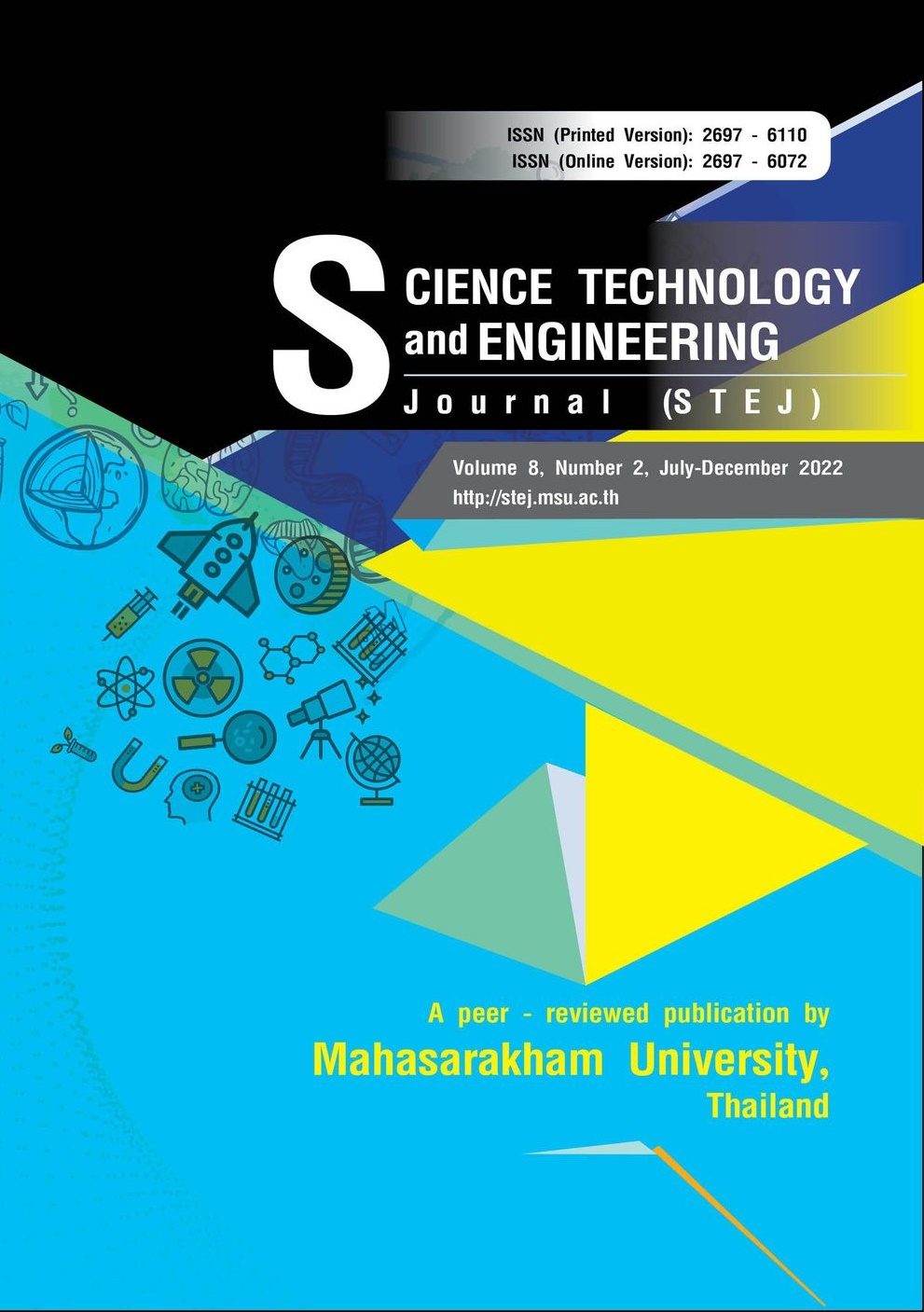Estimation of Ultraviolet Radiation Intensity under Cloudless Sky of Thailand
Keywords:
Estimation, ultraviolet radiation, solar radiation, water vapor, ozoneAbstract
The purpose of this research is to estimate ultraviolet radiation intensity values using mathematical models. Ultraviolet intensity data obtained at a wavelength of 290-390 nm, along with global solar radiation and climate data on cloudless days. The case study of Thailand where the four solar radiation monitoring stations from the North, Northeast, Central and South among them are Chiang Mai, Ubon Ratchathani, Bangkok, and Songkhla provinces respectively. The models were created using data during 2017 to 2019. Following that, the model was validated using 2020 data on a cloudless days. It was found that the intensity of ultraviolet radiation was related to the ratio of solar radiation intensity at the Earth’s surface to extraterrestrial solar radiation intensity and the cosine of the zenith angle. In addition, the intensity of ultraviolet radiation is related to water vapor, ozone content, and visibility data. All of which can show mathematical relationships. The validation results of the model revealed reasonable agreement between the models with a positive correlation with one another. According to the results, all data are not significantly different at the 0.05 level.
References
Barbero, F.J., Lopez, G., & Batlles, F.J. (2006). Determination of daily solar ultraviolet radiation using statistical models and artificial neural networks. Ann. Geophys., 24(8), 2105-2114. https://doi.org/ 10.5194/angeo-24-2105-2006.
Boland, J., McArthur, L.C., & Luther, M. (2001). Modelling the diffuse fraction of global solar radiation on a horizontal surface. Environmetrics, 12, 103-116. https://doi.org /10. 1002/1099-095X(200103)12:2 <103::AID-ENV447>3.0.CO;2-2.
Chadyšiene, R. & Girgždys, A. (2009). Assessment of ultraviolet (UV) radiation from technical Sources. Journal of Environmental Engineering and Landscape Management, 17(3), 164-170. https://doi. org/10.3846/1648-6897.2009.17.164- 170
Habte, A., Sengupta, M., Gueymard, C.A., Narasappa, R., Rosseler, O. & David, M.B. (2019). Estimating ultraviolet radiation from global horizontal irradiance. IEEE Journal of Photovoltaics, 9(1), 139-146. doi: 10.1109/JPHOTOV. 2018.2871780.
Dobson, R. (2005). Ozone depletion will bring big rise in number of cataracts. BMJ, 331(7528), 1292-1295. https://www.ncbi.nlm.nih.gov/ pmc/articles/PMC1298891/
El-Hadidy, M.A., Abdel-Nabe, D.Y., & Kross, P.D. (1990). Ultraviolet solar radiation at Dhahram, Saudi Arabia. Solar Energy, 44(6), 315-319. doi: 10.1016/0038-092x(90)90135-y. https://europepmc.org/article/AGR/ IND90030455.
Elwood, J.M., & Jopson, J. (1997). Melanoma and sun exposure: an overview of published studies. Journal international du cancer, 73(2), 198-203.
Fioletov, V.E. (2008). Ozone climatology, trends, and substances that control ozone. Atmosphere-Ocean, 46(1), 39-67. https://doi.org/10.3137 / ao.460103.
Garrison, J.D. (1992). Estimation of precipitable water over Australia for application to the division of solar radiation into its direct and diffuse components. Solar Energy, 48(2), 89-96.
Godar, D.E. (2005). UV doses worldwide. Photochem Photobol, 81(4), 736- 749. doi: 10.1562/2004-09-07-ir308r.1. https://pubmed.ncbi. nlm. nih.gov/15819599/.
Gueymard, C.A., & Garrision, J.D. (1998). Critical evaluation of precipitable water and atmospheric turbidity in Canada using measured hourly solar irradiance. Solar Energy, 62(4), 291-307. https://doi.org/ 10.1016/ S0038-092X(98)00005-X.
Ineichen, P. (2006). Comperison of eight clear sky broadband models against 16 independent data banks. Solar Energy, 80(4), 468-478. https://doi. org/10.1016/j.solener.2005.04.018.
Iqbal, M. (1983). An introduction to solar radiation. Academic Press.
Janjai, S., Kumharn, W. & Laksanaboonsong, J. (2003). Determination of angstrom’s turbidity coefficient over Thailand. Renewable Energy, 28, 1685-1700. https://doi.org/10.1016/S0960- 1481(03)00010-7.
Khogali, A., & Al-Bar, O.F. (1992). A study of solar ultraviolet radiation at Makkah solar station. Solar Energy, 48(2), 79-87. https:// doi.org/ 10.1016/0038- 092X(92)90036-A.
Krutmann, J., Morita, A., & Chung, J.H. (2012). Sun exposure: what molecular photo dermatology tells us about its good and bad sides. The Journal of Investigative Dermatology, 132(3), 976-984. doi: 10.1038/ jid.2011.394. https:// pubmed.ncbi. nlm.nih.gov/22170486/
Nik, W.B., Ibrahim, M.Z., Samo, K.B., & Muzathik, A.M. (2012). Monthly mean hourly global solar radiation estimation. Solar Energy, 86(1), 379-387. https://doi.org/10.1016/ j.solener.2011.10.008.
Nunez, M., Forgan, B., & Roy, C. (1994). Estimating ultraviolet radiation at the earth’s surface. International Journal of Biometeorology, 38(1), 5-17. doi:10.1007/BF01241798 https://www.researchgate.net/ publication/226388033.
Pinazo, J.M., Canada, J., & Bosca, V. (1995). A new method to determine Angstrom’s turbidity coefficient: Its application for Valencia. Solar Energy, 54(4), 219-226. https://doi. org/ 10.1016/0038-092X(94)00117- V.
Phokate, S. (2020). Estimation of extinction coefficient of solar radiation under cloudless sky in the atmosphere of Thailand. Burapha Science Journal, 25(3), 1083-1093.http://science. buu .ac.th/ojs246/index.php/sci/ article/ view/2996.
Phokate, S. (2017). Atmospheric water vapor: Distribution and empirical estimation in the atmosphere of Thailand. Journal of Physics: Conference Series, 901, 1-6. https://iopscience.iop.org/issue/ 1742-6596/901/1.
Robinson, N. (1966). Solar radiation. Elsevier Publishing Company.
Wei, Q., Lee J.E., Gershenwald J.E., Ross M.I., Mansfield P.F., Strom S.S., Wang L.E., Guo Z, Qiao Y, Amos C.I., Spitz M.R., & Duvic M. (2003). Repair of UV light-induced DNA damage and risk of cutaneous malignant melanoma. Journal of the National Cancer Institute, l95(4), 308-315. doi:10.1093/jnci/95.4.308. https://pubmed.ncbi.nlm.nih. gov/12591987/.
Yin, B., & Jiang, X. (2013). Telomere shortening in cultured human dermal fibroblasts is associated with acute photodamage induced by UVA irradiation. Postepy Dermatologii Alergologii, 30(1), 13- 18. doi: 10.5114/pdia.2013.33374. https://pubmed.ncbi.nlm.nih. gov/24278041/
Downloads
Published
Issue
Section
License
Copyright (c) 2022 Science Technology and Engineering Journal (STEJ)

This work is licensed under a Creative Commons Attribution-NoDerivatives 4.0 International License.





